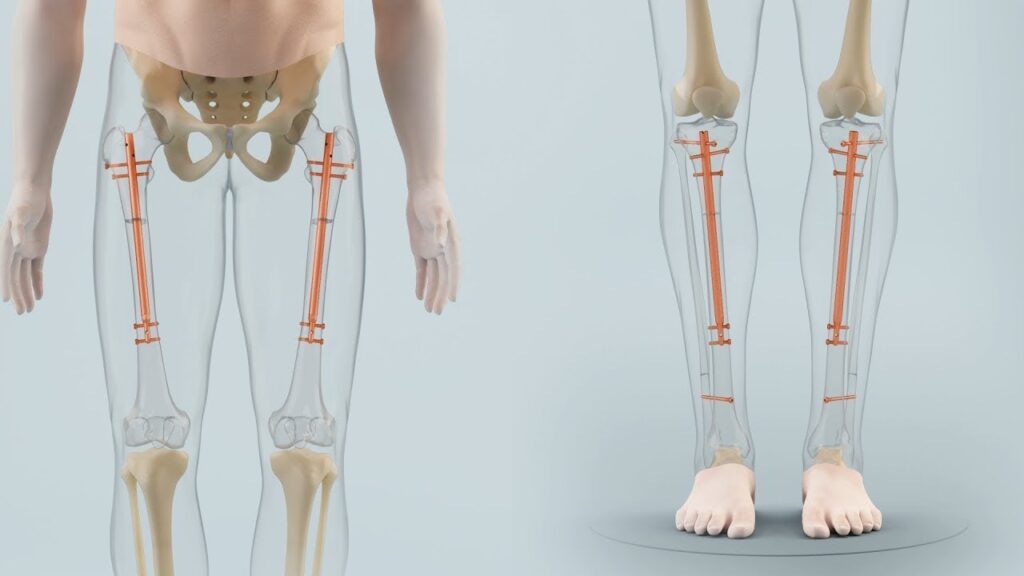Discover the various types of limb lengthening procedures, their methods, benefits, and potential risks involved in these advanced orthopedic surgeries.

Outline
| Headings | Sub-Headings |
|---|---|
| Introduction | – Understanding Limb Lengthening Procedures |
| The Basics of Limb Lengthening Surgery | – What is Limb Lengthening Surgery? |
| – Who Can Benefit from Limb Lengthening Surgery? | |
| Historical Overview of Limb Lengthening | – Early Techniques |
| – Modern Innovations | |
| Types of Limb Lengthening Procedures | – External Fixation Techniques |
| – Internal Lengthening Techniques | |
| – Combined Techniques | |
| External Fixation Techniques | – Ilizarov Method |
| – Taylor Spatial Frame | |
| – Monolateral Frames | |
| Internal Lengthening Techniques | – Intramedullary Lengthening Nails |
| – PRECICE Nail System | |
| – Fitbone Nail System | |
| Combined Techniques | – Using External and Internal Devices |
| – Benefits and Challenges | |
| Procedure and Recovery Process | – Pre-Surgery Preparation |
| – The Lengthening Process | |
| – Rehabilitation and Recovery | |
| Applications of Limb Lengthening Surgery | – Treating Congenital Deformities |
| – Addressing Trauma-Induced Limb Shortening | |
| – Cosmetic Limb Lengthening | |
| Risks and Complications | – Common Surgical Risks |
| – Long-Term Complications | |
| Success Rates and Outcomes | – Factors Influencing Success |
| – Patient Testimonials | |
| Technological Advancements in Limb Lengthening | – Robotics and Automation |
| – Advanced Imaging Techniques | |
| – Future Innovations | |
| Ethical and Psychological Considerations | – Informed Consent |
| – Psychological Impact | |
| Global Perspectives on Limb Lengthening Surgery | – Practices Around the World |
| – Accessibility and Cost Considerations | |
| FAQs | – |
| – What are the different types of limb lengthening procedures? | |
| – How does external fixation compare to internal lengthening? | |
| – What are the risks associated with limb lengthening procedures? | |
| – How long does recovery take? | |
| – Who is a candidate for limb lengthening surgery? | |
| – What advancements are expected in the future of limb lengthening? | |
| Conclusion | – |
Exploring the Different Types of Limb Lengthening Procedures
Limb lengthening surgery has advanced significantly, offering various techniques to address limb discrepancies and improve patients’ quality of life. This article delves into the different types of limb lengthening procedures, exploring their methods, benefits, and potential risks.
Introduction
Limb lengthening procedures are sophisticated surgeries designed to increase the length of bones in the arms or legs. These surgeries can correct congenital deformities, repair trauma-induced shortening, and even enhance cosmetic appearance. Understanding the different types of limb lengthening procedures is crucial for making informed decisions about treatment options.
The Basics of Limb Lengthening Surgery
What is Limb Lengthening Surgery?
Limb lengthening surgery involves the gradual stretching of bones to increase their length. This is achieved through a controlled surgical technique called distraction osteogenesis, where the bone is cut and slowly separated to allow new bone tissue to form in the gap.
Who Can Benefit from Limb Lengthening Surgery?
Individuals with congenital limb length discrepancies, those recovering from traumatic injuries that resulted in limb shortening, and patients seeking cosmetic height enhancements can benefit from limb lengthening surgery. A thorough medical evaluation is essential to determine candidacy.
Historical Overview of Limb Lengthening
Early Techniques
The concept of limb lengthening dates back to ancient attempts using rudimentary methods like traction and splints. These early techniques were often ineffective and fraught with complications.
Modern Innovations
Significant advancements in the 20th century, particularly with the development of the Ilizarov method, revolutionized limb lengthening surgery. Modern techniques now offer more precise, effective, and safer options for patients.
Types of Limb Lengthening Procedures
External Fixation Techniques
External fixation techniques involve attaching a frame to the outside of the limb with pins and wires. These devices allow for precise control over the bone lengthening process.
Internal Lengthening Techniques
Internal lengthening techniques use devices inserted inside the bone, such as intramedullary nails. These methods are less visible and more comfortable for patients.
Combined Techniques
Combined techniques use both external and internal devices, optimizing the lengthening process by leveraging the benefits of each method.
External Fixation Techniques
Ilizarov Method
The Ilizarov method, developed by Dr. Gavriil Ilizarov, uses a circular external fixator to gradually lengthen bones. This technique is highly effective for complex deformities and non-unions.
Taylor Spatial Frame
The Taylor Spatial Frame is a hexapod device that offers precise control over the lengthening process. It is particularly useful for correcting angular deformities and rotational issues.
Monolateral Frames
Monolateral frames are external fixators attached to one side of the limb. They provide simpler, less bulky options for bone lengthening, particularly for less complex cases.
Internal Lengthening Techniques
Intramedullary Lengthening Nails
Intramedullary lengthening nails are inserted inside the bone’s marrow cavity. These devices are adjusted using an external remote control, offering a minimally invasive and less visible option for patients.
PRECICE Nail System
The PRECICE nail system is a motorized intramedullary nail that allows for precise, non-invasive adjustments. This system is widely used due to its accuracy and patient comfort.
Fitbone Nail System
The Fitbone nail system is another intramedullary device that offers controlled, internal bone lengthening. It uses a magnetic mechanism for adjustments, reducing the need for external hardware.
Combined Techniques
Using External and Internal Devices
Combining external and internal devices can optimize the lengthening process, providing the stability of external fixators and the comfort of internal nails.
Benefits and Challenges
Combined techniques offer the benefits of both methods but also present challenges such as increased complexity and the need for careful coordination between devices.
Procedure and Recovery Process
Pre-Surgery Preparation
Pre-surgery preparation includes medical assessments, psychological evaluations, and physical therapy to prepare the limb for surgery and recovery.
The Lengthening Process
The lengthening process involves the initial surgery to cut the bone, followed by the gradual distraction phase where the bone segments are slowly separated to allow new bone formation.
Rehabilitation and Recovery
Recovery includes post-surgery care, physical therapy, and regular follow-up appointments to monitor progress and address any complications.
Applications of Limb Lengthening Surgery
Treating Congenital Deformities
Limb lengthening surgery is often used to correct congenital deformities such as limb length discrepancies and skeletal dysplasia. These procedures can significantly improve mobility and function.
Addressing Trauma-Induced Limb Shortening
Patients recovering from severe trauma that resulted in limb shortening can benefit from limb lengthening surgery. Restoring limb length helps improve balance, gait, and overall functionality.
Cosmetic Limb Lengthening
Cosmetic limb lengthening is an option for individuals seeking to increase their height. This application offers psychological and aesthetic benefits for some patients.
Risks and Complications
Common Surgical Risks
Risks associated with limb lengthening surgery include infection, nerve damage, and blood clots. Surgeons take preventive measures to minimize these risks, but patients must be aware of potential complications.
Long-Term Complications
Long-term complications can include joint stiffness, muscle contractures, and unequal bone growth. Ongoing monitoring and rehabilitation are essential to manage and mitigate these issues.
Success Rates and Outcomes
Factors Influencing Success
The success of limb lengthening surgery depends on various factors, including patient health, adherence to post-surgery care, and the expertise of the surgical team. Successful outcomes are characterized by proper bone healing and improved function.
Patient Testimonials
Many patients report significant improvements in their quality of life following limb lengthening surgery. Testimonials highlight increased mobility, reduced pain, and enhanced self-esteem as common benefits.
Technological Advancements in Limb Lengthening
Robotics and Automation
Robotics and automation are poised to revolutionize limb lengthening surgery by enhancing precision and reducing recovery times. These technologies offer more accurate control over the lengthening process.
Advanced Imaging Techniques
Advanced imaging techniques, such as X-rays and CT scans, are used to monitor the progress of bone lengthening and ensure proper alignment. These technologies help in making accurate adjustments and avoiding complications.
Future Innovations
Future innovations in limb lengthening surgery may include advancements in regenerative medicine, such as stem cell therapy and tissue engineering, offering new solutions for bone regeneration and growth.
Ethical and Psychological Considerations
Informed Consent
Informed consent is a critical aspect of limb lengthening surgery. Patients must fully understand the risks, benefits, and potential outcomes before undergoing the procedure.
Psychological Impact
The psychological impact of limb lengthening surgery is significant. Patients should receive thorough counseling to ensure they are prepared for the emotional and mental challenges of the process.
Global Perspectives on Limb Lengthening Surgery
Practices Around the World
Limb lengthening surgery practices vary across different regions and cultures. Exploring these global perspectives provides a broader understanding of the field and highlights the importance of cultural sensitivity in medical practice.
Accessibility and Cost Considerations
Accessibility to limb lengthening surgery varies by region. Efforts to improve accessibility, especially in developing countries, are crucial for ensuring that more individuals can benefit from these life-changing procedures.
FAQs
What are the different types of limb lengthening procedures?
The main types include external fixation techniques (such as the Ilizarov method and Taylor Spatial Frame), internal lengthening techniques (like intramedullary nails and the PRECICE system), and combined techniques that use both external and internal devices.
How does external fixation compare to internal lengthening?
External fixation involves attaching a frame outside the limb, offering precise control but can be bulky. Internal lengthening uses devices inside the bone, which are less visible and more comfortable for patients but may have limitations in certain cases.
What are the risks associated with limb lengthening procedures?
Risks include infection, nerve damage, joint stiffness, muscle contractures, and unequal bone growth. Preventive measures and careful monitoring help minimize these risks.
How long does recovery take?
Recovery can take several months to a year, depending on the length of bone being lengthened and the patient’s overall health. The process includes a distraction phase and a consolidation phase.
Who is a candidate for limb lengthening surgery?
Candidates include individuals with congenital limb discrepancies, trauma-induced limb shortening, or those seeking cosmetic height enhancement. Proper medical and psychological evaluations are essential.
What advancements are expected in the future of limb lengthening?
Future advancements may include the use of robotics, 3D printing, and regenerative medicine techniques. These innovations aim to improve precision, reduce recovery times, and enhance patient outcomes.
Conclusion
Limb lengthening surgery offers a range of procedures to address various conditions and improve patients’ quality of life. Understanding the different types, benefits, and risks of these procedures can help individuals make informed decisions and achieve successful outcomes.



